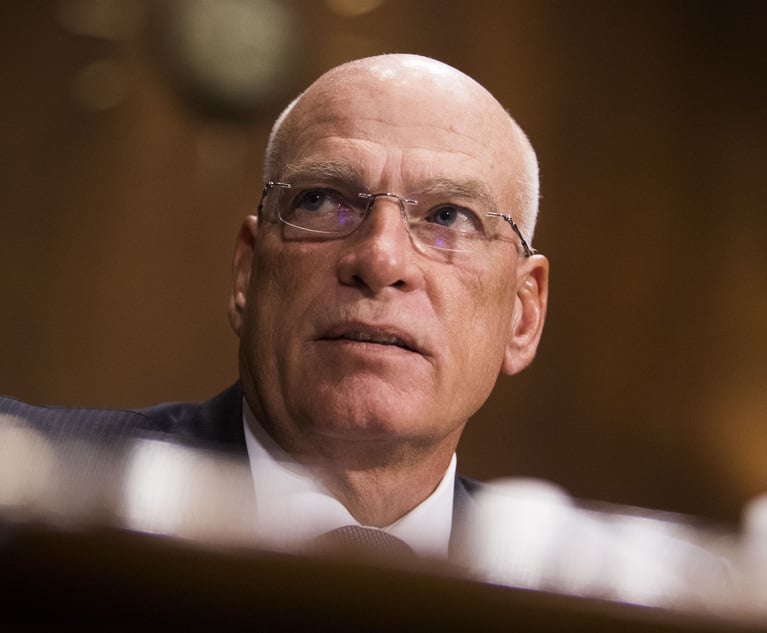With SCOTUS Cloud Overhead, Appeals Courts Take Up Travel Ban 3.0
Two federal appeals courts will hear oral arguments this week on the third iteration of President Donald Trump's travel ban, but a sweeping ruling Monday from the U.S. Supreme Court does not bode well for plaintiffs.
December 05, 2017 at 05:43 PM
7 minute read
 Photo: Diego M. Radzinschi/ALM.
Photo: Diego M. Radzinschi/ALM.
The task awaiting attorneys for two sets of plaintiffs challenging the legality of President Donald Trump's third travel ban policy just got a lot more difficult.
Both the U.S. Court of Appeals for the Ninth and Fourth circuits will hear oral arguments this week on whether they should uphold lower courts' injunctions against the Sept. 24 proclamation, the third iteration of the travel ban. While appellate courts have now upheld injunctions against both the original January order and the March 6 order, much has changed in the travel ban litigation since. The recent injunctions, issued within hours of each other by district courts in Maryland and Hawaii in October, may not withstand legal scrutiny like their predecessors.
That's because the Supreme Court allowed the ban to fully go into effect Monday while the lower courts consider the cases. That's a stark change from how the court handled injunctions against the March 6 version of the ban, when it ruled to temporarily keep the ban enjoined except for those with no “bona fide” relationships to the United States. Plaintiffs attorneys will head into circuit court hearings Wednesday and Friday with the spectre of the sudden change at the high court weighing over their heads.
“Given [Monday's] ruling, both the Fourth and the Ninth circuit are going to try to be extra careful in justifying however they come out,” said Stephen Yale-Loehr, an immigration law professor at Cornell University and of counsel at Miller Mayer. “I think [the] Supreme Court orders signal that the administration may well win at the Supreme Court and that may influence, to a certain extent, how the Fourth and the Ninth circuit rule.”
Two Democrat-appointed justices, Sonia Sotomayor and Ruth Bader Ginsberg, dissented from Monday's order. That means two other Democrat-appointed justices, Stephen Breyer and Elena Kagan, agreed with the decision to allow the full ban to go into effect.
Jon Meyer, a partner at Sheppard, Mullin, Richter & Hampton who served as deputy general counsel at the Department of Homeland Security in the Obama administration, said that does not bode well if the case reaches the high court.
“To me, that signals the other Democrat-appointed justices may be OK with the travel ban as a legal matter, even if they aren't as a policy matter.”
It's possible the Ninth and Fourth circuits judges, who will hear arguments on the ban on Wednesday and Friday, respectively, will have this in mind when mulling the case. The same judges that heard arguments over the March 6 ban in both courts will handle the Sept. 24 ban.
In the Fourth Circuit, that means an en banc hearing. In the Ninth Circuit, the three-judge panel consists of Michael Hawkins, Ronald Gould and Richard Paez, all appointed by Democrats. Both circuits are considered to lean to the left.
But, as Meyer pointed out, the facts of the case have changed since the circuit courts considered the March 6 ban in May. The new ban, issued via proclamation the same day the second ban expired, bars the issuance of visas to immigrants from six majority-Muslim countries as well as Venezuela and North Korea.
The administration argues the ban is the result of a comprehensive review of, and report on, foreign countries' vetting and information-sharing processes. While the legal record on the first and second travel ban orders did not reveal much in terms of the administration's reasons for implementing nationality-based rules, the government says the restrictions now in place, which vary based on country, are designed to encourage those countries to adhere to proper procedures.
That shift could be why the Supreme Court had a change of heart. The court has typically shown deference to the government in the immigration context, choosing often not to infringe on the executive's powers when it comes to foreign relations. The government only needs a “facially legitimate and bona fide reason” to issue the order.
As David Bier, an immigration policy analyst at the libertarian Cato Institute, put it, “as long as the justification is mainly one that's not religious, it's going to pass constitutional muster.”
With the new review and report, the argument that the government has a justified reason for the ban is stronger than before, Yale-Loehr explained.
“For that reason, although an objective person may question how thorough the review is or whether it really matches up with what's going on, given the very low standard of review, the Supreme Court may well say, it isn't perfect but it's good enough,” Yale-Loehr said.
But the plaintiffs, which include the state of Hawaii in the Ninth Circuit as well as various individuals and immigrant organizations in both, say the restrictions are applied haphazardly and that applying nationality-based rules to immigrants doesn't meet the stated goal of ensuring better information sharing between countries.
They also continue to point to the president's tweets and public statements about Muslims, which were a focus of previous circuit court opinions. Plaintiffs claim Trump's failure to renounce prior statements about Muslims shows a continued animus toward that religion motivates the bans.
Just last week, Trump retweeted anti-Muslim videos posted by a far-right British group. Later that day, Hogan Lovells' Neal Katyal, who represents plaintiffs in the Ninth Circuit, tweeted a press report about Trump's tweets with the caption “Thanks! See you in court next week.”
However, Meyer noted that months have past since the statements made during the campaign or transition period that truly connect any animus on Trump's part to the policy now in place.
“The law is often about line-drawing and some judges and other lawyers have been troubled by the question of, at what point does that no longer apply?” he said.
But another part of the argument against the ban is based on the language of the immigration laws, as opposed to the constitutional arguments, Bier noted. The statutory argument by plaintiffs is that the Immigration and Nationality Act bars nationality discrimination in the “issuance of visas.”
The Sept. 24 ban deals directly with issuing visas, whereas prior orders were entry-bans, but the INA language specifically refers to issuing visas.
“So now the arguments on this point are really focused on, well, does the authority to prohibit entry actually also apply to visa issuance, or trump the prohibition on visa issuances?” Bier said. “[The government's] approach to implementation has really led to a complication for them in their arguments. It's easier to implement but probably harder for them to argue for in court. ”
In addition to Katyal, Hogan Lovells senior associate Mitch Reich will argue in the Ninth Circuit Wednesday. In the Fourth Circuit, Cecilia Wang of the American Civil Liberties Union will represent the various organizational plaintiffs and individuals Friday. Justice Department lawyer Hashim Mooppan will argue in the Ninth Circuit as well as the Fourth, where he'll be joined by Lowell Sturgill.
The Ninth Circuit arguments are set to begin at 2 p.m. Wednesday. Arguments before the Fourth Circuit are scheduled to begin at 9 a.m. Friday. Both will be livestreamed.
This content has been archived. It is available through our partners, LexisNexis® and Bloomberg Law.
To view this content, please continue to their sites.
Not a Lexis Subscriber?
Subscribe Now
Not a Bloomberg Law Subscriber?
Subscribe Now
NOT FOR REPRINT
© 2025 ALM Global, LLC, All Rights Reserved. Request academic re-use from www.copyright.com. All other uses, submit a request to [email protected]. For more information visit Asset & Logo Licensing.
You Might Like
View All
'Erroneous Assumption'?: Apple Challenges DOJ Antitrust Remedy in Google Search Monopoly Case
3 minute read
'Unlawful Release'?: Judge Grants Preliminary Injunction in NASCAR Antitrust Lawsuit
3 minute read
Federal Judge Grants FTC Motion Blocking Proposed Kroger-Albertsons Merger
3 minute read
Frozen-Potato Producers Face Profiteering Allegations in Surge of Antitrust Class Actions
3 minute readTrending Stories
- 1Supreme Court To Review Second Circuit Decision Striking Down 'Deemed Consent' Law Reaching PLO and PA for Making Payments to 'Martyrs' Who Injure or Kill US Nationals
- 2McDermott Adds Covington, Polsinelli Laterals to Build DC Bench
- 3From TAR to Generative AI: A Revolution in Document Review
- 4Legal Tech's Predictions for E-discovery in 2025
- 5Lessons Learned from the Pager Attack: the Law of War, Warfighting, and the Weaponization of the Supply Chain
Who Got The Work
Michael G. Bongiorno, Andrew Scott Dulberg and Elizabeth E. Driscoll from Wilmer Cutler Pickering Hale and Dorr have stepped in to represent Symbotic Inc., an A.I.-enabled technology platform that focuses on increasing supply chain efficiency, and other defendants in a pending shareholder derivative lawsuit. The case, filed Oct. 2 in Massachusetts District Court by the Brown Law Firm on behalf of Stephen Austen, accuses certain officers and directors of misleading investors in regard to Symbotic's potential for margin growth by failing to disclose that the company was not equipped to timely deploy its systems or manage expenses through project delays. The case, assigned to U.S. District Judge Nathaniel M. Gorton, is 1:24-cv-12522, Austen v. Cohen et al.
Who Got The Work
Edmund Polubinski and Marie Killmond of Davis Polk & Wardwell have entered appearances for data platform software development company MongoDB and other defendants in a pending shareholder derivative lawsuit. The action, filed Oct. 7 in New York Southern District Court by the Brown Law Firm, accuses the company's directors and/or officers of falsely expressing confidence in the company’s restructuring of its sales incentive plan and downplaying the severity of decreases in its upfront commitments. The case is 1:24-cv-07594, Roy v. Ittycheria et al.
Who Got The Work
Amy O. Bruchs and Kurt F. Ellison of Michael Best & Friedrich have entered appearances for Epic Systems Corp. in a pending employment discrimination lawsuit. The suit was filed Sept. 7 in Wisconsin Western District Court by Levine Eisberner LLC and Siri & Glimstad on behalf of a project manager who claims that he was wrongfully terminated after applying for a religious exemption to the defendant's COVID-19 vaccine mandate. The case, assigned to U.S. Magistrate Judge Anita Marie Boor, is 3:24-cv-00630, Secker, Nathan v. Epic Systems Corporation.
Who Got The Work
David X. Sullivan, Thomas J. Finn and Gregory A. Hall from McCarter & English have entered appearances for Sunrun Installation Services in a pending civil rights lawsuit. The complaint was filed Sept. 4 in Connecticut District Court by attorney Robert M. Berke on behalf of former employee George Edward Steins, who was arrested and charged with employing an unregistered home improvement salesperson. The complaint alleges that had Sunrun informed the Connecticut Department of Consumer Protection that the plaintiff's employment had ended in 2017 and that he no longer held Sunrun's home improvement contractor license, he would not have been hit with charges, which were dismissed in May 2024. The case, assigned to U.S. District Judge Jeffrey A. Meyer, is 3:24-cv-01423, Steins v. Sunrun, Inc. et al.
Who Got The Work
Greenberg Traurig shareholder Joshua L. Raskin has entered an appearance for boohoo.com UK Ltd. in a pending patent infringement lawsuit. The suit, filed Sept. 3 in Texas Eastern District Court by Rozier Hardt McDonough on behalf of Alto Dynamics, asserts five patents related to an online shopping platform. The case, assigned to U.S. District Judge Rodney Gilstrap, is 2:24-cv-00719, Alto Dynamics, LLC v. boohoo.com UK Limited.
Featured Firms
Law Offices of Gary Martin Hays & Associates, P.C.
(470) 294-1674
Law Offices of Mark E. Salomone
(857) 444-6468
Smith & Hassler
(713) 739-1250










